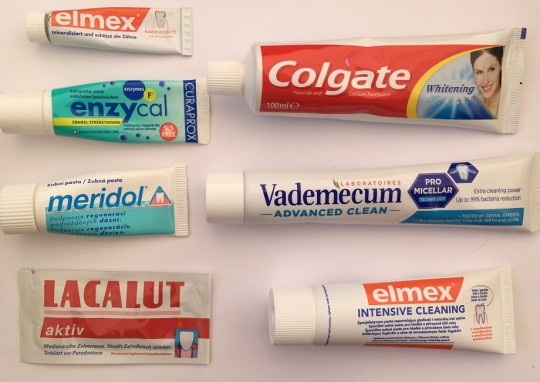1.2
Toothpaste
It is a substance used with a toothbrush to remove bacterial plaque, debris from the gingiva, and for applying specific agents to the tooth surfaces for preventive or therapeutic purposes.
1.2.1
Early toothpastes
The Egyptians made a tooth powder in 5000 BC. It was composed of powdered ashes of hooves, myrrh, powdered and burnt eggshells, and pumice. Later, the Greeks and the Romans improved it by adding abrasives such as bones and oyster shells. Toothpastes or powders came into use in the 19th century. They were mostly homemade. It consisted of chalk, pulverized brick, or salt. In 1880 toothpastes were sold in collapsible tube. The idea was taken from painters using paint from tubes.
1.2.2
Basic components
The toothpaste is made up of water (20-40 %) and of variety of components mainly of abrasives, fluoride, and detergents.
Abrasives
- help clean, remove plaque from teeth, polish teeth. They left the tooth shiny and surface resists discoloration and bacterial accumulation.
- mostly they include particles of calcium carbonate, calcium pyrophosphate
- the abrasivity of toothpastes is usually determined by the REA (relative enamel abrasion) or RDA (relative dentine abrasion) value:
This scale rates dental products numerically, the higher the number, the higher the abrasivity.
Fluorides
- active ingredient to prevent cavities, enhance remineralisation of incipient lesions, alter the action of plaque bacteria, reduce enamel solubility and increase enamel resistance
- has positive effect on the formation of dental enamel and bones
- are taken not only from toothpaste and mouthwash but can be found in fluoridated water (tap water), supplemental tablets, and in small amounts in foods
- the teeth can acquire fluoride during three periods. The mineralization stage – when the tooth develops, after mineralization – before eruption, and after eruption
- the optimum level for water in our climate is 1ppm
- the level in toothpaste is different according the age of customer:
- we should be aware of swallowing a large amount of toothpaste which contains fluoride because of its toxicity
- Sodium fluoride (NaF) is the most common source of fluoride. Stannous fluoride (SnF2) is more effective in reducing of carries, but causes surface stains
Surfactants
- improve cleansing power of toothpaste
- used for better feeling of users
Flavorants are used for better taste and for encouraging use of product flavorants. Mainly peppermint, spearmint, wintergreen, etc.
We can find other components that influence type of toothpaste and its purpose of using.
Toothpaste for prevention gingivitis. It contains antibacterial agents (triclosan or zinc chloride).
Dentifrices are used for preventing dental carries. Xylitol is usually used.
When there is a necessity of reformation of enamel we can use a toothpaste with remineralizers (calcium phosphates).
Children toothpastes usually contain sweet flavour (fruit or bubble gum). There is the risk of swallowing of this toothpaste and intake a large amount of fluoride!
+

Fig. 9. Children toothpastes
Whitening toothpastes may include abrasives to gently polish the teeth, or additives such as sodium tripolyphospate to break down stains, or peroxide again for removing stains. All these toothpastes cannot change the natural colour of teeth or reverse discoloration. There is risk of permanent reduction of the strength of the teeth because a protective outer layer of enamel is taken away.
+

Fig. 10. Toothpastes
Vocabulary
English | Czech | English | Czech |
braces | rovnátka | dentures | zubní protézy |
bridge | můstek | implants | implantát |
interdental toothbrush | mezizubní kartáček | inaccessible | npřístupný |
wires | drátky | coding probe | velikostní sonda |
pocket set | cestovní krabička | dental floss | zubní nit |
straight | rovný | angled | zahnutý |
waxed | povoskovaný | cause | příčina |
insertion | vsunutí | snapping | přetrhnutí |
curving | zahnutí | prongs | vidlice, hroty |
blast | odfoukne | stick | párátko |
rigid | neohebný | essential oil | éterické oleje |
occurrence | výskyt | rinse | vypláchnout |
balloon | nafouknout | suck | vcucnout |
expectorate | vyplivněte | bacterial count | počet bakterií |
side effect | vedlejší účinek | stain | skvrna |
burning | pálivý | sensation | pocit |
temporarily | dočasně | debris | zbytky |
purpose | účel | ash | popel |
hooves | kopyta | myrrh | myrha |
eggshells | skořápky vajíček | pumice | pemza |
chalk | křída | brick | cihla |
collapsible | rolovací | abrasives | abraziva |
enhance | zvýšit | incipient | počáteční léze |
lesions | léze | discoloration | odbarvení |
solubility | rozpustnost | swallow | spolknout |
stannous | cínatý | flavorants | aromatické látky |
single end brush | solo kartáček | crowded teeth | stěsnané zuby |
corn starch | kukuřičný škrob | biodegradable | odbouratelný |
charcoal | dřevěné uhlí | bamboo | bambus |
©
For licensing reasons, this interactive object cannot be directly incorporated into the material. Click HERE to see the object.
Translate and write (the user will be redirected to an external page)